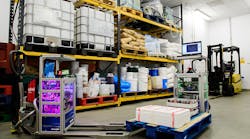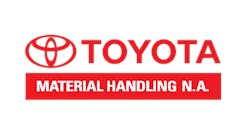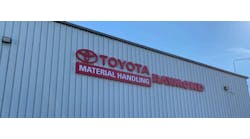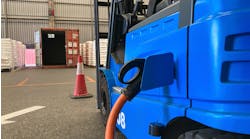Who's driving that forklift? The correct answer might be, "no one."
A project called ILIAD (Intra-Logistics with Integrated Automatic Deployment) has scientists developing new fleets of autonomous "self-optimizing" forklift trucks which can operate safely and efficiently in warehouses alongside human co-workers.
The goal of the project, a multinational collaboration between robotics specialists in the UK, Sweden, Italy and Germany, is to enable deployment of next-generation automated guided vehicles (AGVs) into current warehouse facilities to support tasks such as packing, palletizing and transporting goods.
A key requirement is that each robot is "human aware" – equipped with advanced computer vision and artificial intelligence to detect, track and predict the behavior of humans and to plan movements based on the machines’ own observations of warehouse lay-outs and patterns of activity.
Each robotic vehicle will be self-optimizing, learning from self-collected data over time, making the fleets fully scaleable with the option of adding or removing robots at any time.
The project is part of the EU’s Horizon 2020 fund and is a consortium led by by Örebro University in Sweden, and includes University of Lincoln, UK, University of Pisa, Italy, and Leibniz University, Hannover, Germany, working with major industrial partners Bosch, Kollmorgen Automation, ACT Operations Research, Logistic Engineering Services and Orkla Foods.
While the aim is to develop a reliable robotic solution flexible enough to support intra-logistics in many different industries, the researchers will use the fresh food sector as their development setting. This is due to the industry’s particularly challenging requirements: short shelf life of products, need for complete traceability, high cost of wastage, and pressure for rapid responses to changing market needs.
"The project will push the state-of-the-art in human-robot interaction, overcoming persistent barriers to greater adoption of automation in logistics operations in many industries, starting with the food sector,” explains Tom Duckett, director of the Lincoln Centre for Autonomous Systems (L-CAS) at the University of Lincoln and a principal investigator on the ILIAD project:
"The fleets will be self-deploying and self-optimizing, removing much of the capital cost and disruption of introducing robotic technologies," adds Duckett. “Most importantly, though, we will show that autonomous vehicles can operate safely and efficiently alongside human co-workers and human-driven vehicles in complex, dynamic warehouse settings."
Movement costs per pallet and per case are tracked as key performance indicators in most warehousing and distribution operations, he notes. "Robots seamlessly integrating alongside humans, often working collaboratively, will unlock significant productivity advances in the sector while also serving to help address anticipated challenges resulting from increased competition and escalating operating costs over the coming years."
The project is coordinated by Achim Lilienthal, professor of Computer Science at Örebro University and head of the Mobile Robotics and Olfaction Lab at Örebro University. "In addition to the development of self-deploying and self-optimizing fleets of autonomous vehicles that are able to unwrap pallets and manipulate stacked goods, this project is crucially interested in safety and the collaboration of robot and humans," says Lilienthal.” Safety is addressed by developing means of highly reliable human detection and tracking, and a systematic integration of safety considerations into the ILIAD system."



